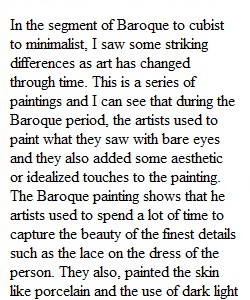


Q You will notice that, depending on how we situate any one work of art, it can occupy various positions within a sequence. For example, in this lesson, van Gogh's Ravine could be part of a first-phase development in which Robert Rauschenberg's Bed was a second phase and Tony Smith's Die or Rauschenberg's Monogram was part of a third phase. In contrast, during a previous lesson, Ravine was the third phase, while Rembrandt's Woman Wearing a Gold Chain was in the second phase and van der Weyden's Saint Luke Drawing the Virgin was the first phase. This is one of the first times we've looked at painting in our tripartite structure. Reflect on what similarities and differences you can find between the way we've looked at the evolution of sculpture and the way we can look at a similar evolution painting. What elements do you notice? For example, in the Rembrandt, what is similar to both the Doryphoros and the sculptures at Reims Cathedral and Michelangelo's David? We are learning to speak about painting in a way that accords with sculpture.
View Related Questions